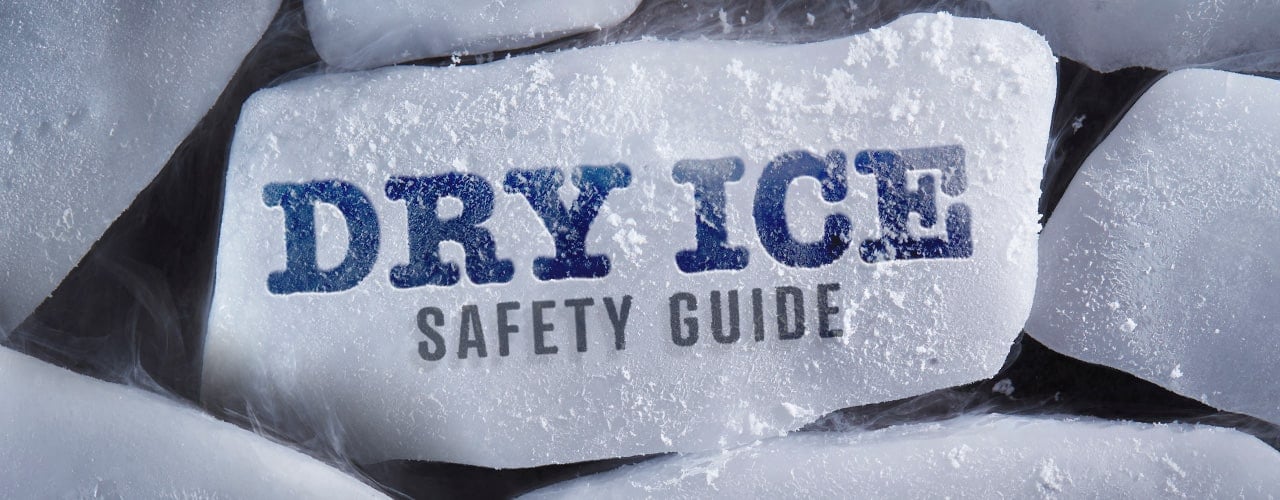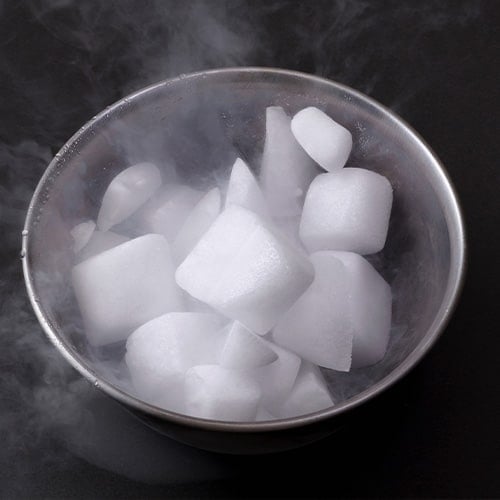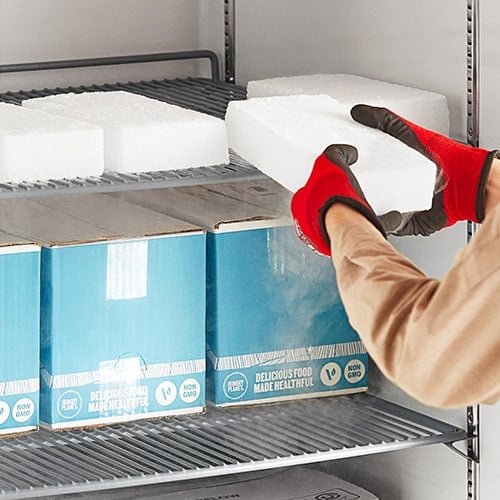
Dry ice is a useful tool in the foodservice industry, often used for shipping perishable goods or keeping foods cold at offsite catered events. It may seem harmless, but business owners must understand the potential hazards associated with handling dry ice before incorporating this product into their operations. We've created a comprehensive guide to dry ice safety, providing crucial information on proper storage, handling, and disposal techniques to ensure the well-being of both employees and customers. By following these guidelines, you can harness the benefits of dry ice while minimizing the risks involved.
What Is Dry Ice?

Unlike regular ice, which is the solid form of a liquid, dry ice is the solid form of a gas (carbon dioxide). It's extremely cold, reaching temperatures of -109.3 degrees Fahrenheit. Dry ice is commonly used in commercial applications for its unique properties, including its ability to rapidly freeze and maintain low temperatures.
Instead of melting like regular ice, dry ice changes directly from a solid to a gas. This makes it ideal for preserving perishable goods during shipping, creating dramatic effects in the entertainment industry, and conducting scientific experiments. Due to its extremely cold temperature, handling dry ice requires caution and proper safety measures to avoid frostbite or other injuries.
What Is Dry Ice Sublimation?
Dry ice sublimation is the process by which solid dry ice transitions directly into a gas without going through a liquid phase. As the dry ice warms up, instead of melting, it undergoes sublimation and changes to carbon dioxide gas. This sublimation process is what creates the fog effect that's so popular. Even though it looks impressive, the fog produced by dry ice can become hazardous in confined spaces with no ventilation.
Can Dry Ice Be Dangerous?
Yes, dry ice has the potential to become dangerous. Because it's frigidly cold, dry ice can freeze the skin and cause severe burns. As dry ice sublimates or changes into a gas, it can displace oxygen in small spaces and cause asphyxiation. Those hazards sound scary, but you can avoid accidents and keep employees safe by following our tips for handling dry ice the right way.
How Long Does Dry Ice Last?
On average, dry ice sublimates at a rate of about 5 to 10 pounds per day in a typical cooler or insulated container. This translates to roughly 0.2 to 0.4 pounds per hour. If you're using dry ice in larger quantities or a non-insulated environment, the sublimation rate may be higher. For example, if you're transporting a large number of perishable goods in a truck without proper insulation, the sublimation rate can increase to about 10 to 20 pounds per day or 0.4 to 0.8 pounds per hour.
To maximize the lifespan of your dry ice and minimize waste, you must handle it properly. Always store dry ice in a well-insulated container, such as a cooler, insulated box, or a dry ice container. Fill any gaps in the container with rolled-up paper. This helps to slow the sublimation process.
How to Handle Dry Ice
Watch this quick video for a dry ice handling tutorial:
Transporting Dry Ice
When it comes to transporting dry ice and planning a safe event, it's important to follow proper safety protocols to prevent any accidents or injuries. Here are some dry ice facts to keep in mind when transporting this icy product:
- Use insulated containers: Dry ice should always be transported in insulated containers to maintain its temperature and prevent it from sublimating too quickly. These dry ice containers are designed to keep the dry ice cold and prevent the build-up of pressure.
- Ventilation: It's recommended to transport containers of dry ice in a ventilated space like a truck bed so that any sublimated gas can escape. The last thing you want to do is accidentally fill your vehicle with carbon dioxide while you are driving. This has the potential to become dangerous for the driver and passengers.
- Secure the containers: To avoid any mishaps during transit, it's essential to secure the containers properly. This will prevent them from shifting or falling over, which could cause damage or injury. Make sure the containers are tightly sealed and stored in a stable position to maintain their integrity.
- Labeling: Clearly label all containers that contain dry ice to alert others to the potential hazards. Include information such as "Dry Ice" and "Ventilate" so that anyone handling or coming into contact with the containers is aware of the safety precautions they need to take.
- Avoid direct contact: Never handle dry ice with bare hands or allow it to come into direct contact with your skin. Always use protective gloves or tongs to handle dry ice, as it can cause frostbite or burns if not handled properly.
- Plan your route: Plan your route ahead of time to minimize the time spent in transit. The longer the dry ice is in transit, the more it will sublimate, leading to a loss of its cooling properties. By planning your route efficiently, you can make certain that the dry ice remains effective for as long as possible.
By following these guidelines for transporting dry ice, you can promote safety and maintain the quality and effectiveness of the dry ice. Remember, proper handling and transportation methods will prevent accidents and ensure a smooth and successful operation.
Dry Ice Storage

Storing dry ice properly is essential to the safety of both individuals and the surrounding environment. Here are some key facts and guidelines to follow when storing dry ice:
- Choose the right storage container: Dry ice should always be stored in a well-insulated container that can withstand extremely low temperatures. The container should have a tight-fitting lid but shouldn't be completely airtight, because the buildup of gas pressure can cause the container to burst.
- Do not store dry ice in a refrigerator or freezer: It's a common misconception that dry ice can be stored in a freezer. Believe it or not, the icy-cold temperature in your freezer is not cold enough for dry ice. The dry ice will start to sublimate (turn into gas) and cause several issues. The enclosed airtight freezer will fill up with carbon dioxide, which becomes a safety hazard for anyone who uses the freezer. The extremely low temperature of dry ice can also cause the thermostat to malfunction, leading to spoilage of food or damage to the appliance.
- Store in a cool, dry place: Dry ice should be stored in a cool and dry place away from direct sunlight, heat sources, and moisture. Exposure to heat or moisture can cause the dry ice to sublimate more quickly, reducing its shelf life.
- Keep the storage area well-ventilated: Always store dry ice in a well-ventilated area to prevent the buildup of carbon dioxide gas. Carbon dioxide is denser than air and can displace oxygen, leading to asphyxiation in confined spaces. If storing dry ice in a small room or enclosure, double-check that there is proper ventilation to allow the gas to dissipate.
Please Note: If you are using dry ice to keep perishable foods cold during a power outage, keep these things in mind. It's possible to place dry ice in a non-operational refrigeration unit during an emergency, but the dry ice will begin to sublimate and fill the cabinet with gas. You must have a safe plan to periodically release the gas so that the cabinet doesn't rupture from the pressure. Instead, we recommend placing dry ice in insulated coolers and moving your perishable items into the coolers until the power is restored. Again, always place the coolers in a well-ventilated area.
Back to TopHow to Dispose of Dry Ice Safely

How do you get rid of dry ice once you no longer need it? Proper disposal plays a large part in the safe handling of this useful product. Keep these recommendations in mind when it comes to disposing of dry ice:
- Allow the dry ice to sublimate: One of the reasons that dry ice is so convenient to use is that it sublimates into a gas and essentially disappears into thin air. Even so, it's important to allow the dry ice to naturally sublimate in a well-ventilated area. Never dispose of dry ice in a closed container, as this can cause a dangerous buildup of pressure.
- Ventilation is key: We've mentioned ventilation several times in this article because it's required in all stages of dry ice handling. Choose an outdoor area or a well-ventilated room and avoid disposing of dry ice in confined spaces, such as a car trunk or a small closet.
- Use protective gear: When handling dry ice, you must protect yourself by wearing appropriate PPE. This includes insulated gloves to prevent frostbite and safety goggles to protect your eyes from ice chips or debris.
- Break up the dry ice: To speed up the sublimation process, you break up the dry ice into smaller pieces. Place the dry ice in a plastic bag and use a hammer or mallet to gently break it apart. Remember to wear protective gloves while doing this to avoid direct contact with the dry ice.
- Avoid flushing down drains or toilets: Never dispose of dry ice by flushing it down drains or toilets. The freezing cold temperature of dry ice can cause damage to pipes and plumbing systems, leading to costly repairs.
- Consult local regulations: Before disposing of dry ice, check with your local waste management authorities for specific guidelines and regulations. Some areas may have specific requirements for the disposal of dry ice, such as drop-off locations or designated collection points.
By following these guidelines, you can promote the safe and responsible disposal of dry ice. Remember, proper disposal not only protects your safety but also helps to preserve the environment. Always prioritize safety when handling and disposing of dry ice.
How to Treat a Dry Ice Burn
Brief skin contact with dry ice will cause red irritation, but prolonged contact will result in an iceburn. If the burn is minor it can usually be treated with items in a typical first aid kit. However, if the burn appears to be severe, you should seek medical attention immediately. Signs of a severe burn include:
- The burn covers a large area of the body
- The skin appears charred or white
- The burn is deep and causes intense pain
- The burn is on the face, hands, or feet
In these cases, it's best not to take any chances and consult a healthcare professional as soon as possible. They will be able to assess the burn and provide appropriate medical treatment. For a minor burn, follow these steps:
- Soak the exposed area in lukewarm water for about 20 minutes. This should provide some relief.
- After soaking, clean the burned area with mild soap and water. Be gentle to avoid causing further discomfort or damage to the skin.
- Once the area is clean, cover it with a sterile, non-stick dressing or bandage. This will protect from infection and help promote healing.
Dry Ice FAQ
We answer common questions about dry ice safety below:
Is Dry Ice Edible?
No, dry ice is not edible and should never be ingested. It's made of carbon dioxide in its solid form and can cause serious harm if consumed. When dry ice comes into contact with moisture in the mouth or digestive system, it rapidly converts from a solid to a gas, causing a significant increase in pressure. This can result in tissue damage, burns, and even rupture of the stomach or intestines. Keep dry ice out of reach of children or anyone who may mistakenly think it is edible.
Can I Touch Dry Ice with Bare Hands?
Never touch dry ice with bare hands, because it can freeze the skin and cause frostbite. Always use insulated gloves or tongs to keep your hands safe when handling dry ice.
Is it Dangerous to Inhale Dry Ice Fumes?
Yes, inhaling dry ice fumes can be potentially dangerous. Dry ice is the solid form of carbon dioxide and when it sublimates, it releases carbon dioxide gas. Inhaling high concentrations of carbon dioxide can lead to symptoms such as dizziness, shortness of breath, and even loss of consciousness. Proper ventilation is critical when working with dry ice. If you experience any symptoms of carbon dioxide exposure, seek fresh air immediately.
Does Dry Ice Affect Those with Asthma or Allergies?
Dry ice releases carbon dioxide gas as it sublimates, which can cause respiratory distress for individuals with asthma. The frigidly cold temperature of dry ice can trigger allergic reactions in some individuals. Always take the proper precautions when handling dry ice to keep individuals safe, especially those with respiratory conditions or allergies.
Back to TopAs a restaurant owner or caterer, it's imperative to prioritize the safety of your staff and customers when handling dry ice. By following proper guidelines, you can ensure a smooth and secure experience. Educate your staff on the proper handling procedures to make sure they understand the potential hazards associated with dry ice. By implementing these safety measures, you can confidently incorporate dry ice into your restaurant or catering operations while keeping everyone safe.





